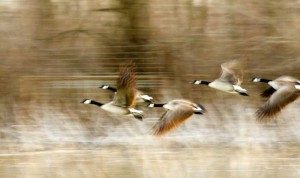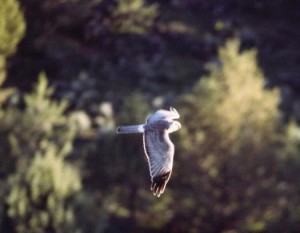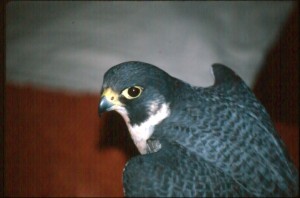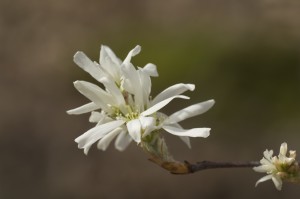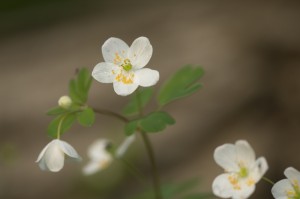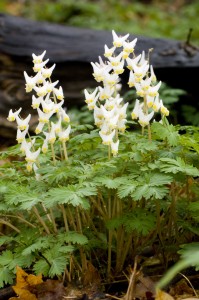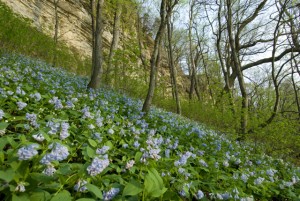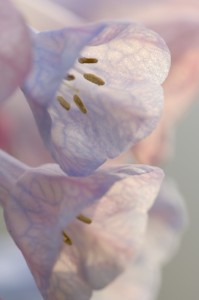Enduring Natural Rhythms Toll in Springtime Wonders
A March morning in the bluffs is only as drab as one who walks in it without looking skyward, for, in March, the sky-clock clearly is set at springtime. Trumpeting skeins of geese — Greater White-fronted speckle bellies, Ross’s, Snowies, and Canadas — winging through the skies, draw eyes and hopes upwards: northward bird migration has begun. The minute-by-minute increase in daylight hours since December’s winter solstice alters brain and body chemistry in animals so that the ongoing necessity of finding food to survive through winter is joined by the imperatives of mating and reproduction.
Two magnificent species of raptors begin to depart their winter ranges in March, heading for their northern breeding territories. Northern Harriers often can be seen in our area in the winter, while the more rarely seen Peregrine Falcons also grace our winter skies.
Harriers, also called “Marsh Hawks,” are a common sight coursing over fields, especially over the American Bottoms, in winter. Owl-faced, about two-feet long, with a wingspan of almost four feet, they easily are recognized by their low, skimming and graceful flight over wetlands and fields as they forage for rodents and other small prey.
Harriers are among the few raptor species in which males and females have differently colored plumage. Adult females are brown above with white breast and belly feathers heavily streaked with brown. Adult males are grayish above and mostly plain white below. Both males and females sport a white rump patch, while males also show black wing tips. As with many raptors, females are larger than males.
Their name, derived from an old English word meaning to rob, pillage or torment, was, perhaps, an attempt to describe how potential harrier prey must feel as the birds methodically course over the ground in search of unwary rodents. Harriers seem to set up distinct search patterns as they skim along near the ground, with their heads pointed down, watching and listening, in an undulating flight that follows the nape of the earth. Once a potential meal is spotted, however, the lazy, easy flight is broken as a bird will quickly bank and turn, fanning its tail and then quickly punch toward the ground, sharp talons extended, ready for a mouse or vole meal.
A far different, though equally methodical, hunting strategy is followed by Peregrine Falcons. Also called “Duck Hawks,” Peregrines winter along the Mississippi River and the Atlantic and
Gulf Coasts. Slightly smaller than Harriers, both adult male and female Peregrines are gray above and show dark head feathering which extends, helmet-like, in a wedge below the eye. Peregrines primarily hunt waterfowl and other smaller birds, and often will target their prey from a considerable distance and then swiftly fly in pursuit. The final aerial hunt often is concluded by a steep vertical dive which has been clocked at speeds of up to 250 miles per hour. That we may thrill at the sight of a wintering Peregrine is only due to an intense reintroduction program.
The naturally occurring population of Peregrines in the Eastern U.S. and Canada, a subspecies called the “Rock Peregrine,” became extinct in the early 1960s, a loss largely attributed to the pesticide DDT. This pesticide, extensively used to control insects on crop and forest lands from 1946 to the early 1970s, undergoes chemical transformation in animals and increases in both concentration in tissue and effects as it moves up the food chain. As plants, insects, spiders and other food items that were exposed to DDT were eaten by birds, which, in turn, became food for peregrines and other raptors, the amount and resulting toxicity increased. The metabolized pesticide did not kill adult birds; rather it made the females less able to produce calcium. Eggs produced by the birds had shells so thin that the weight of the incubating adult birds simply crushed and destroyed the eggs.
Captive breeding programs, begun in the 1970s, have resulted in the release of more than 6,000 Peregrines in Canada and the U.S. The Midwest recovery effort was begun in Minnesota in 1982. But, the Peregrines of the Midwest and the Eastern U.S. are not the same as the Peregrine population that had lived here. The captive-raised birds and their descendants are the result of breeding efforts with up to 12 different subspecies of birds, including some from Europe.
Another reintroduction success story and increasingly seen winter visitor to our area are Trumpeter Swans. The largest waterfowl in North America, adults are four feet tall, with a seven-foot wingspan, and can
weigh up to 30 pounds. Because of their size, they need 500 feet of water to get airborne. Adults are all white but the youngsters are tawny-grayish buff through their first spring, seemingly needing a full year’s sun to bleach their feathers into snow white. Trumpeter Swans have all black bills, unlike Tundra Swans, which often show a small yellow patch, or the nonnative Mute Swans, with their orange bills surmounted by a black knob.
Historically, trumpeters bred from Northern Illinois northward into Canada and wintered all along the Mississippi. Loss of wetlands habitat and over hunting brought trumpeters to near extinction, with only 100 birds remaining in North America in 1930. Captive breeding programs and reintroductions, along with recreations of wetlands, have increased their numbers to 4000 in the lower 48 states and to 12,000 in Alaska.
In early November, a mated pair — Trumpeter Swans take lifelong mates — visited wetlands in the American Bottoms of Monroe County and stayed for about a week. During the week of January 14, a second pair and three youngsters stayed at the large lake in Randolph County Conservation Area.
This family of visiting swans turned out to be “Illinois’ First Family” for they are the first pair to breed in Illinois in over two centuries. The identification numbers on their neck bands showed that the male (called a cob) was hatched and raised in a Chicago-area zoo; the female (called a pen) had been hatched and raised in Iowa. Both birds were released in Iowa, where they met and “married,” subsequently relocating to a new home along the Mississippi River in Carroll County, Illinois. They bred successfully in 2006 and 2007 and brought three chicks (called cygnets) to our part of Illinois this winter.
As Northern Harriers, Peregrines and Trumpeter Swans begin northward migration, some of our earliest spring flowers begin to garland the bluffs.
Amelanchier arborea often is the first, widely prevalent plant to flower in our bluff’s woods. The small bushy tree produces numerous clusters of small, five-petaled, white flowers, with each flower resembling a small
five-bladed propeller. Amelanchier ranges throughout Canada and the northern half of the Eastern U.S. It has many common names throughout its range. In our neck of the woods and throughout the Midwest, it’s mostly called “serviceberry.” Early settlers dubbed it such because it bloomed when church services reopened after the long, hard winter, which made travel to meeting areas difficult, was over.
Along the East Coast, the early flowering tree is called “shadbush,” because it blooms when shad fish began their migration upriver from the sea. In Canada, the plant is called “saskatoon,” after a Cree word for its berries. The ripe fruits also gave the plant an alternate name throughout its range — Juneberry.
Serviceberry’s juicy blue-black fruits have been put to a variety of uses. Early settlers ate them fresh and used them for jams and cakes. Native Americans used the berries to sweeten pemmican and also made an infusion from the tree’s bark to cure intestinal worms. But any person hoping for a feast of serviceberry fruits is in hard competition with birds and mammals who also find the fruits delectable.
The white flowers of False Rue Anemone (Enemion biternatum) are among the earliest spring flowers to decorate the forest floor. With five petal-like sepals, about one-half inch across, the delicate little plant has
compound leaflets of three, each divided into three lobes. It can be found along our bluff land’s moist creek hollows, with sizable colonies along Fults Road, Trout Camp Road, and Dennis’ Hollow (Highway 156) in Monroe County, and Maple Hollow Road in Randolph County.
Also blooming white in March and early April, are Dutchman’s Breeches (Dicentra cucullaria). Their three-quarter inch long, sometimes pink- or yellow-tipped white flowers have double spurs and, indeed, look like an upside-down pair of old-fashioned pantaloons. Their leaves are fern-like in appearance, finely dissected and cut into a lacy pattern.
Many Native American peoples utilized infusions of the plant’s leaves for a liniment to soothe and heal aching muscles. Early settlers made a tea from the bulbs to promote sweating and as a curative for urinary
difficulties. The leaves of Dutchman’s Breeches contain an alkaloid that can produce a narcotic effect, called “blue staggers,” by the early settlers who discovered this ill result. The bulbs of the plant can kill cattle in large amounts. Today, all parts of the plant are considered poisonous.
But a view of Dutchman’s Breeches, carpeting the forest along moist and shaded roadways and at the base of our bluff slopes is anything but toxic. And, if the Dutchman’s Breeches are accompanied by Virginia Bluebells, the effect can be intoxicatingly beautiful.
Arguably the most beautiful of our early spring wildflowers, Virginia Bluebells (Mertensia virginica) bring a touch of sky-blue heaven to our
bluffs, often blooming even as the last snow melts.
Their porcelain-blue flowers are trumpet-shaped, with numerous blossoms hanging in loose clusters; individual flowers turn lavender, then pink as they age.
They often form large colonies, covering the forest floor with a tapestry of blue, which, sadly, lasts for only a couple of weeks. After flowering and seed-set, the entire plant enters dormancy, dying back and leaving no trace at all of its graceful presence until next spring. Large colonies of bluebells are easily viewed along Bluff Road between Columbia and Valmeyer on the talus slope below the bluff face.
The skies — filled with the urgency of birds migrating north — and the wildflowers — beginning to peek through last autumn’s leaf mulch — tell us spring is here. As we reset our clocks to daylight savings time this March, and try again to convince ourselves of our clever alchemy in transforming a morning sunbeam into a more lingering sunset, the enduring rhythms of nature have long-since tolled in the wonders of springtime.
Clifftop, a local nonprofit organization, is focused on preserving and protecting area bluff lands.
A version of this article appeared in the March 5 2008 edition of the Monroe County Clarion.
© 2008 all content rights reserved, Clifftop NFP.
Comments are currently closed.

